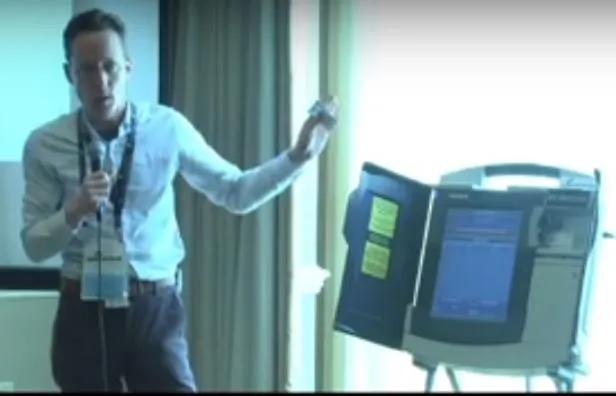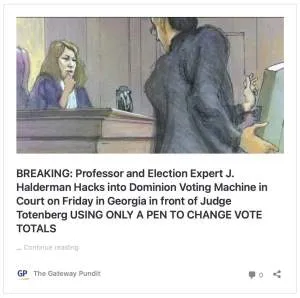(Gateway Pundit) On Friday, in a Federal Court In Atlanta, Georgia, University of Michigan Professor of Computer Science and Engineering J. Alex Halderman testified in front of Judge Amy Totenberg’s courtroom in the Culling vs. Raffensperger lawsuit on the insecure Dominion voting machines used in Georgia elections since 2020.
As reported earlier, during his testimony, Halderman was able to HACK A DOMINION VOTING MACHINE and change the tabulations in front of U.S. District Judge Amy Totenberg and the entire courtroom!
Halderman USED ONLY A PEN TO CHANGE VOTE TOTALS!
His testimony was part of a long-running lawsuit by election integrity activists set as a bench trial.
The plaintiffs seek to remove what they say are insecure voting machines in Georgia in favor of secure paper ballots.
This lawsuit was launched after the 2017 Kennesaw State University election hacks in Georgia.
As we continue to follow this explosive lawsuit on election integrity today The Gateway Pundit looked into the FBI’s role in this operation.
We can finally explain what happened over the years.
Here is a timeline of the Georgia voting machine hacking scandal:
In August 2016 cyber security researchers Logan Lamb and Christopher Gray discovered it was easy to access the Georgia voting databases. This included staff passwords, access to software that runs the devices, and data on their 6.7 million voters. Lamb notified KSU of the security vulnerabilities. KSU asked Lamb to keep quiet. Over the next few months, KSU elections IT staff noticed intrusion attempts by DHS. KSU Elections Systems answered to Brian Kemp, Georgia’s Secretary of State at that time.
In December of 2016, to appease the KSU IT staff, Kemp sent a letter to DHS Secretary Jeh Johnson. He asked why the DHS tried to penetrate Georgia’s election servers at least 10 times. Other DHS attacks were documented to be Nov. 7th and 8th, the day before and the day of Trump’s election win. But Kemp’s letter only asked about one specific attempt, a week after the election, on November 15th at 8:43 AM. He did not mention these other attacks. The Digital Forensics and Analysis Unit of the DHS OIG were tasked to investigate this one instance. Was it deliberate to focus on just this one instance?
In March 2017, a few months later, the KSU servers were breached. They were hacked, data was deleted, and altered. Because of the previous whistleblower warnings, Kennesaw State’s CIO Stephen Gay was forced to alert their Center for Elections Systems about this “data breach”. Gay also had to contact the FBI. The FBI opened an investigation into the hacking. The FBI went to KSU and made forensic images of the election servers.
In June 2017, Republican Karen Handel beat Jon Osoff by 3.8% in a District 6 runoff election. Liberal activists alleged the system might have been hacked. On July 3rd 2017, they filed a lawsuit in Fulton County Superior Court (Curling v. Kemp). Their lawsuit wanted Georgia to replace the outdated (DRE) election machines. The lawyers who defended SOS Kemp in this lawsuit were from the Georgia AG’s office.
Two days later after the (Curling v Kemp) lawsuit was filed, the DHS responded to Kemp’s KSU intrusion letter, sent 7 months earlier. The DHS OIG concluded the “November 15th scan” was residual traffic from an employee at the Federal Law Enforcement Training Center. They said that the employee was just checking the Georgia firearms license database. The OIG said Microsoft Engineers even agreed. That was it, case closed. There was no investigation into intrusion occurrences that occurred the day before, during, and day after the 2016 election.
Three days after the (C v K) lawsuit was filed, the administration at KSU had their staff delete all the election servers. Their IT staff admitted they DBAN’d (nuked) the servers. Their internal KSU emails showed on July 6th 2017, that “election hard drives were degaussed three times”. The backup servers were deleted on August 9th. This data removal was kept from the public, until October 2017, when journalists obtained those KSU’s internal emails.
The Georgia AG’s office, those defending Kemp, continued to lie to the Plaintiffs. The AGI said the server data could not be provided, it was deleted before their lawsuit. But the AG’s office knew KSU ordered the servers to be wiped after the lawsuit was filed. These AG lies were made public when the “Georgia Wipes Servers” story broke on October 26th 2017 and showed the KSU emails. A few days later, Assistant AG Cristina Correia withdrew the entire AG’s office from the (C v K) case due to “newly found” conflicts of interest. The Plaintiffs immediately requested the FBI turn over their copy of the KSU servers. The FBI stalled this release for 26 months, with no justification why.







